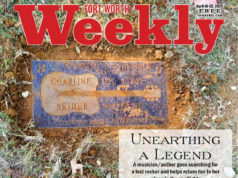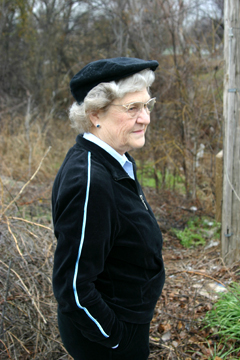 On a stark February morning, trees have shed their leaves, and the creek looks naked, forlorn, and scarred by the paper cups, beer cans, and assorted trash that cling to banks and branches. Stripped by winter and trashed by man, the creek somehow remains lovely, a beautiful problem child with an occasional habit of running loose and flooding streets, homes, and businesses. Burgen has worked for a quarter-century to achieve flood control on Johnson Creek without ruining the stream’s natural feel, its canopies, birds, and critters. “There is something about a wild creek that bespeaks things much larger than we are,” she said.
On a stark February morning, trees have shed their leaves, and the creek looks naked, forlorn, and scarred by the paper cups, beer cans, and assorted trash that cling to banks and branches. Stripped by winter and trashed by man, the creek somehow remains lovely, a beautiful problem child with an occasional habit of running loose and flooding streets, homes, and businesses. Burgen has worked for a quarter-century to achieve flood control on Johnson Creek without ruining the stream’s natural feel, its canopies, birds, and critters. “There is something about a wild creek that bespeaks things much larger than we are,” she said.
Poetic notions aside, this wild creek, like thousands before it, will surely bow before the force of nature known as economic development. Environmentalists are but pesky flakes of dandruff on the collectively broad shoulders of Jerry Jones and the Dallas Cowboys and Tom Hicks and the Texas Rangers and Glorypark and eager-beaver city officials led by Arlington Mayor Robert Cluck. Sixteen months ago, Arlington voters approved a tax increase to raise $325 million to help the Cowboys build a state-of-the-art football stadium (imagine a cross between a spaceship and a Jell-O mold). City officials saw it as a green light to invigorate the amusement mecca and grab some national spotlight. They envision Super Bowl celebrations, river walks, and the magical sound of a thousand cash registers ringing in unison. Glorypark’s mix of retail, residential, and office space is poised to inject millions of dollars into the city’s tax base.
It’s a giddy time in this suburb perched midway between Fort Worth and Dallas. The once-tiny town with big dreams had fumbled the can-do spirit that made it one of the fastest-growing cities during the last half of the 20th century. The past decade sent it teetering toward a future as just another flat, ugly, blue-collar town with a pathological fear of poor people, an underachieving baseball team, an aging amusement park. The Cowboys and Glorypark are being counted on to slow that trend. The question is, will the end justify the means? Murmurs of discontent about methods used by the city, developers, and politicians are tarnishing this golden project for many observers. People get antsy when they see laws changed to suit the needs of the rich and powerful. They get angry when cities wield the power of eminent domain like a Louisville Slugger. Hushed mouths and closed-door meetings threaten their sense of open government. Cutting trees in what was once wild parkland raises eyebrows.
Between May 2005 and February 2006, Arlington city, state, and Congressional officials worked together quietly to change state law, decertify a federal wildlife designation, and slip a vaguely worded note onto a city council agenda, in order to turn 22 acres of parkland along Johnson Creek into even more parking for that shiny new Cowboys stadium — a move that once would have required a vote of the public, not to mention a little public debate. “They have skirted the will of the taxpayer,” Arlington attorney James Runzheimer said. Or maybe they’re doing exactly what most voters wanted when they approved stadium funding to make the entertainment district shine like Oz. The vote was close, but on Nov. 2, 2004, those who favored a new stadium won the day. Arlington hitched its wagon to Jones, Hicks, and the modern phenomenon of sports complexes as economic generators, and at this point, the attitude seems to be that anyone who doesn’t climb aboard can choke in their dust.
A couple of years ago, the city of Round Rock, near Austin, wanted money to improve its parks and to provide more youth activities. No biggie — State Rep. Mike Krusee introduced a bill in the Texas Legislature in 2005 to allow the use of municipal hotel occupancy tax dollars for the enhancement of sports facilities. What happened after that, however, was another illustration of the old rule about not watching how sausage or laws are made in Texas. Along the way, an amendment was tacked on that allowed cities to skip the public referendum that is normally required to turn dedicated parkland to other uses. The amendment allowed parkland to be converted for “an approved venue project” — like, say, the new Cowboys stadium. Krusee’s chief of staff Wendy Reilly expressed surprise at the twist of events. “Our bill was just a bill to allow hotel and motel taxes to be used for other purposes, like for parks and kids’ sports,” she said. Two years after the fact, she was unsure how the amendment had been added. She researched the situation and called back two days later with an update. “It was put on in the Senate,” she said. “Once it leaves our possession and goes to the other chamber, they can do whatever with it. … It’s kind of the nature of the beast over here.”
She had one other bit of information: “I think it was Sen. [Kim] Brimer who put it on there,” she said. Indeed, the Republican senator who represents Tarrant County had added the amendment. The bill eventually returned to the House for ratification of the changes, but Krusee didn’t object to the amendment. Like many politicians, he tries to get along with his peers and doesn’t object to them tacking on amendments “unless it changes his bill and does the opposite of what he’s trying to do,” Reilly said. Politicians usually let their peers know about any amendments being added to their bills, but not always. “I don’t remember Brimer’s office calling us,” she said. So what motivated Brimer? His legislative director, Trent Townsend, described it as a “cleanup” amendment — “changes that needed to be made to the original sports and community venue bill.” That original legislation, authored by Brimer, was passed into law in 1997 to authorize cities and counties to build sports venues with voter approval.
When asked if the cleanup amendment was added for the sake of the Cowboys, Townsend said he would ask Brimer. In subsequent interviews, Townsend reported that Brimer had said only that the amendment was something “the cities” desired. State Rep. Lon Burnam of Fort Worth said he didn’t notice Brimer’s amendment when it was added in 2005. Now, he laments the way in which the system was used to benefit the stadium project at the expense of public input. “It’s a regrettable subterfuge,” he said. “You have to understand there are usually ulterior motives involved in a lot of these amendments. Unfortunately it happens that way in the Texas Legislature all the time.” Trey Yelverton, Arlington’s deputy city manager for economic development, said he wasn’t aware of any lobbying of Brimer by city officials for such a change. “To my knowledge, the city wasn’t pushing the legislative agenda regarding that,” he said. “I just know that the bill was passed and was available, and when we talked about how to do that [allow the Cowboys to use parkland for parking], that became the vehicle by which it could be done. I don’t know if the Cowboys advanced that legislation or not.”
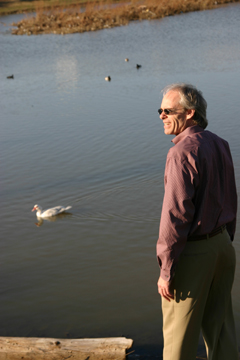 Yelverton said it was the Cowboys organization that pointed out the change to city officials. After that, the issue went to the city council and then into closed session. “We worked through the city council and talked to them about the interest in providing a segment of that land for the venue,” he said. Cowboys officials offer a slightly different perspective. Their organization supported Brimer’s proposal, as did Mayor Cluck, according to team spokesman, Brett Daniels. “Mayor Cluck was also very supportive of it passing because it allowed the city to condemn less land,” he said. “They were able to use land they had already controlled, rather than having to condemn other additional private property.” Cluck did not respond to interview requests. The land in question — a tree-covered strip near the creek — had been rated as high-quality wildlife habitat by the U.S. Fish and Wildlife Service in 1992 and 1998 and was intended for use in Johnson Creek conservation efforts.
Yelverton said it was the Cowboys organization that pointed out the change to city officials. After that, the issue went to the city council and then into closed session. “We worked through the city council and talked to them about the interest in providing a segment of that land for the venue,” he said. Cowboys officials offer a slightly different perspective. Their organization supported Brimer’s proposal, as did Mayor Cluck, according to team spokesman, Brett Daniels. “Mayor Cluck was also very supportive of it passing because it allowed the city to condemn less land,” he said. “They were able to use land they had already controlled, rather than having to condemn other additional private property.” Cluck did not respond to interview requests. The land in question — a tree-covered strip near the creek — had been rated as high-quality wildlife habitat by the U.S. Fish and Wildlife Service in 1992 and 1998 and was intended for use in Johnson Creek conservation efforts.
Just because the possibility existed of making the move without a public vote didn’t mean it had to be done that way, of course. Arlington Mayor Pro Tem Ron Wright said, however, that he saw no need to put the issue to a public vote — the change was just something that needed to happen to make the creek and entertainment district a boon for the entire city for years to come. “The bottom line is this: When it’s finished, more people are going to be able to enjoy the creek in more ways than was ever possible in the past,” he said. Brimer’s amendment and its outcome came as a shock to the Arlington Conservation Council, a nonprofit environmental organization. In the past, the city had asked voters for their approval to turn over parkland for development — state law required it. For instance, in 2004 almost three out of four voters approved allowing economic development on seven acres of parkland at Harold Patterson Sports Complex. But a year later, the city turned over almost three times that much land to Jones and the Cowboys without asking voters or even letting them know what was happening.
Residents couldn’t figure out how the city pulled off such a trick. Their inquiries to city officials netted vague responses. “If I have any gripe, it’s primarily by the process of how this has happened,” Burgen said. The whole thing seemed sneaky, with deals made behind closed doors. In February 2006, the city council approved an item that had been discussed earlier in executive session. The nature of the item wasn’t clear; the agenda simply described it as an amendment to the Cowboys lease agreement. Two weeks later, the meeting’s minutes were posted on the city’s web site and gave more detail on how City Councilman Gene Patrick “made a motion to a resolution authorizing the mayor … to add [to the Cowboys project] approximately 22.49 acres of land previously identified for the Johnson Creek project.” Conservationists were horrified — a wildlife area designated for creek conservation efforts as part of a U.S. Army Corps of Engineers project had been handed over for a parking lot, and it had been done without public discussion — in fact, in ways that specifically avoided public discussion. “They did everything under cover,” Arlington resident Ron Staples said. “They didn’t want anybody to know about it; if they had, everybody would have been upset.”
Even if the newly amended state law OK’d the subterfuge, the conservationists wondered, how had the federal government allowed it, when federal dollars had already been spent on the land as part of the conservation project? The answer: another quiet move by another Texas elected official, this one in Washington, D.C. At the request of city officials, U.S. Rep. Joe Barton had pushed a bill through Congress to decertify the acreage from the Corps project and transfer it to the stadium project. Wright denied there was anything wrong with how the transfer played out. “There was nothing sneaky about it,” the mayor pro tem said. No election was needed when the 90 acres was designated for creek conservation as part of a federal project, he said, so why should a local election be needed to decertify a portion of the property? Also, he said, the city has “replaced” the lost acreage, meaning that another wooded area in another part of town will receive the wildlife designation. “Since we replaced the parkland that was removed from the [creek] project, why would we go back to the voters?” he said. “It’s just a swap of land.” Critics are quick to point out that the replacement land on the city’s far west side — including about six acres that was once home to a junkyard — isn’t comparable in quality.
A natural creek corridor exists unbroken throughout the city, but improvements in the entertainment district will fragment that corridor, Burgen said. “All the creatures that were living along there had to go someplace else. The migratory birds really used the Johnson Creek corridor in their migrations. It’s things like this, in many cities, across the migratory area, that is causing their populations to decrease.” Some of the environmentalists accused Wright of misleading them because he told them last year that the 90 acres near the creek wouldn’t be affected by the stadium project. Wright remembers those conversations differently — he recalls being asked whether the entire 90 acres would be used in the stadium project and saying he didn’t think it would. “Things get twisted; people’s memories lapse,” he said. “I never said a portion of the acreage wouldn’t be used.”
The spirit of the law might have been gored, but the letter of the law apparently wasn’t broken — a city attorney assured council members that the land could be used for the stadium project and that it was OK to discuss the move in closed sessions. Lease agreements, as real estate transactions, can be discussed privately. Not everyone agrees with that interpretation. “The 90 acres was public land that was part of the approved Johnson Creek project, and its removal was never an item for public discussion, and it wasn’t disclosed to the public until it was done,” Burgen said. By then, resistance was moot — the land, once thick with trees, had been cleared. Since then, the Cowboys determined they wouldn’t need quite as much land for parking as originally thought, and the city is now providing 17 acres, said Parks and Recreation Director Pete Jamieson. But trees had already been cleared off the full 22.
The city has plans to improve drainage and conservation efforts along Johnson Creek throughout the city in the coming decades. However, the current focus is squarely on the portion of the creek that lies within the entertainment district. The city can accomplish its goals of adding walking trails and picnic areas even without the relatively small amount that was handed over to the Cowboys, Jamieson said. “Our objectives are to restore some stability to the creek and facilitate good pedestrian access and general mobility in the area, and we’re going to be able to accomplish that with or without that 17 acres,” he said. “We’re trying to preserve wildlife but also protect investments on either side of the creek.” Maybe so, but veiling the process is an affront to democracy, creek advocate Bonnie Bowman said. “It’s scary,” she said. “Everybody should be upset about this. They are our representatives, and if you don’t know how they are making decisions, you lose representation.”
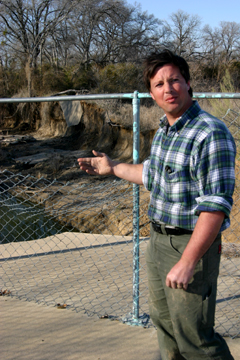 Wright agreed that the city council sometimes discusses issues in executive session that seem to be public matters. The city attorney determines which topics should be protected from public discourse. City council members have the right to trump his decision but seldom do. Real estate issues can be sensitive, Wright said. Closed-door meetings about the 22 acres were being held at the same time the city was involved in disputes over its use of eminent domain to take property in the area. “We don’t have to have those [discussions] in executive session, but the city attorney normally will recommend to protect the legal interests of the city,” he said. “The city attorney is your lawyer, and when he tells you it’s in the best interest of the city legally in terms of liability and exposure to do it in executive session, you have to be careful.” Bowman suspects Arlington officials’ covert decision-making was a way to avoid naysayers and reduce obstacles. Soliciting public input can be a pain in the butt to politicians with a dream. “That just slows things down,” she said. “But democracies are messy. Democracies around controversial subjects are even messier.”
Wright agreed that the city council sometimes discusses issues in executive session that seem to be public matters. The city attorney determines which topics should be protected from public discourse. City council members have the right to trump his decision but seldom do. Real estate issues can be sensitive, Wright said. Closed-door meetings about the 22 acres were being held at the same time the city was involved in disputes over its use of eminent domain to take property in the area. “We don’t have to have those [discussions] in executive session, but the city attorney normally will recommend to protect the legal interests of the city,” he said. “The city attorney is your lawyer, and when he tells you it’s in the best interest of the city legally in terms of liability and exposure to do it in executive session, you have to be careful.” Bowman suspects Arlington officials’ covert decision-making was a way to avoid naysayers and reduce obstacles. Soliciting public input can be a pain in the butt to politicians with a dream. “That just slows things down,” she said. “But democracies are messy. Democracies around controversial subjects are even messier.”
The same sentiment was put more bluntly by Fred Mitchell, who was forced to sell his home near Johnson Creek after the city used its power of eminent domain in 2004 to buy and remove houses in a floodplain — even though his house had never flooded in 40 years: “The people are getting screwed, and they just keep doing it in this damned city,” he said. The creek that runs through Arlington’s entertainment district was there long before the whoosh of roller coasters, the crack of baseball bats, and the slabs of concrete that were laid to accommodate apartments, stores, parking lots, and sports venues. Urban growth is seldom kind to creeks. Added runoff from pavement-covered land means more water hurtling along its channels, eroding walls, widening banks, dislodging trees by the roots, and sending silt downstream to cause drainage problems. Many cities do what’s financially practical — pave the channel and fuggetaboutit.
Arlington has danced with this issue for years. City leaders lean toward using tax money to help the creek and then use the prettified creek as bait to attract business developments and increase tax revenues. The city’s voters want to control water and maintain some greenery, but they apparently don’t want their taxes used to create creekside paradises for the benefit of rich capitalists. Twice in the 1990s, Arlington voters were asked to consider a major overhaul of Johnson Creek, including amenities to attract economic development. Twice voters refused. They favored efficiency and minor recreational amenities using federal funds and the U.S. Army Corps of Engineers expertise. But, bless their hearts, the voters have a soft spot for sports venues. In 1991 they approved a half-cent sales tax increase to provide $135 million toward the Ballpark in Arlington (now Ameriquest Field). They have supported the Rangers through thin and thin. How could they resist rolling out the red carpet for the Silver and Blue?
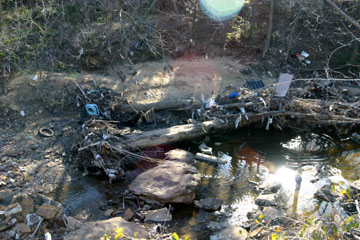 Few voters even thought about Johnson Creek when approving tax increases to fund the Cowboys’ new home. They didn’t realize the stadium project and adjoining Glorypark development would, in effect, overturn their earlier votes against using their taxes to pay for extensive creek work for the sake of developers. About $14 million earmarked for creek improvements in the entertainment district is coming from a tax increment reinvestment zone — money from entertainment district taxes will be reinvested there rather than being spread around the city. Establishing tax increment finance (TIF) districts is common among cities trying to spur development, but it’s a controversial practice. Using tax money to pay for creek improvements to benefit stadium and Glorypark development flies in the face of what voters have twice made clear, said attorney Runzheimer. “The taxpayers turned down the use of public money for the restoration of Johnson Creek, and this TIF uses public money in the magnitude of $14 million on the creek,” he said. “Given the magnitude of [the creek project] and particularly since taxpayers had voted down Johnson Creek, it seems that any changes to the creek should be subject to a bond election where residents have time to research and discuss the changes,” he said. “What they weren’t able to obtain through two sales tax elections they’ve put into this TIF without the voters’ approval.”
Few voters even thought about Johnson Creek when approving tax increases to fund the Cowboys’ new home. They didn’t realize the stadium project and adjoining Glorypark development would, in effect, overturn their earlier votes against using their taxes to pay for extensive creek work for the sake of developers. About $14 million earmarked for creek improvements in the entertainment district is coming from a tax increment reinvestment zone — money from entertainment district taxes will be reinvested there rather than being spread around the city. Establishing tax increment finance (TIF) districts is common among cities trying to spur development, but it’s a controversial practice. Using tax money to pay for creek improvements to benefit stadium and Glorypark development flies in the face of what voters have twice made clear, said attorney Runzheimer. “The taxpayers turned down the use of public money for the restoration of Johnson Creek, and this TIF uses public money in the magnitude of $14 million on the creek,” he said. “Given the magnitude of [the creek project] and particularly since taxpayers had voted down Johnson Creek, it seems that any changes to the creek should be subject to a bond election where residents have time to research and discuss the changes,” he said. “What they weren’t able to obtain through two sales tax elections they’ve put into this TIF without the voters’ approval.”
City officials view things differently. Wright sees the failed bond elections as voters saying they didn’t want to raise the sales tax to pay for creek improvements. “That’s not what we’re talking about here,” he said. Creating a TIF will generate about $11 million in taxes for creek improvements, with another $4 million pledged by Jones and Hicks. So the city is getting millions of dollars in creek work without raising the sales tax rate. And don’t forget, Wright said, the creek was long overdue for a facelift even before the Cowboys or Glorypark developments occurred. Lamenting the loss of wildlife parkland for a parking lot is understandable, but don’t ignore the long-term effects of creek renovation in the entertainment district — increased property values, more development, a stronger tax base for the entire city, and the protection of other parkland, said Jamieson, the parks director. “It’s important we step back and look at the bigger picture,” he said. “A few years ago, we had to make some dramatic cuts to our budget. What’s occurring out in the entertainment district is one of many strategies that the city can employ to improve our financial situation and allow us to increase the capacity to maintain the rest of the parks system.”
Traipsing along Johnson Creek is tricky, considering the steep banks and tangled undergrowth. On a recent afternoon, Mark O’Leary’s boots and jeans bore muddy evidence of a day spent studying ways to tame the creek without stripping it of its natural beauty. O’Leary is senior ecologist with Applied Ecological Services, a Wisconsin-based consulting company that was paid $600,000 to come up with a conservation plan for the entertainment district’s portion of the creek. He is convinced that Arlington, along with officials overseeing the stadium and Glorypark projects, are sincere in their desire to improve the creek’s ability to handle flash floods while maintaining some of its natural beauty. Most cities prefer the cheapest and most efficient way to tame floodwaters and are happy to do so with concrete — and plenty of it. “Arlington is going the extra mile to keep it as green as possible,” he said.
O’Leary said the creek will look more beautiful than ever once the work is done, with flowers, grasses, and trees dominating banks that are now mostly covered in dense thickets that make it difficult for trees to become established. “All these trees that are being choked out will be liberated,” he said. “Other specimen trees will be coming in. You’ll see more people using the trails. There will be wetland habitat.” Left alone, a creek has a mind of its own. A tree that dies and falls into the creek can dam it up and cause the waters to change course and streambed curves to widen — not a good thing when a creek is coexisting with homes and businesses. A widened curve means a property owner just lost some of his lot. O’Leary pointed out an area of the creek near Ameriquest Field’s southwest parking lot. A concrete sidewalk that once bordered the creek has now collapsed into it because of bank erosion. If the erosion isn’t contained, it’s only a matter of time until the parking lot itself begins to crumble into the creek. A hike-and-bike trail that was built 30 feet from the banks only six years ago is now being swallowed by the ever-widening creek, forcing the city to prevent access by visitors. “The creek keeps trying to make itself bigger and bigger to accommodate the water,” O’Leary said. “It is obviously unstable now.”
City leaders insist that being proactive and containing the creek in an area where hundreds of millions of dollars are being invested is a no-brainer. Stabilizing a creek can reduce sedimentation and cut maintenance costs. But it gives conservationists ulcers to see the work done. Trees get cut, slopes get graded, and wildlife habitats get demolished. In time, however, things grow back and often look better than before, O’Leary said. “It’s going to be a big shock to come in here and start pulling trees out, but there are a lot going back in,” O’Leary said. “This is going to be cool. Imagine the Goodyear blimp flying over during a game and seeing the stadium, the ballpark, the Johnson Creek restoration.” People who want the creek left in its “natural state” are overlooking the fact that Johnson Creek hasn’t been in a natural state for as long as most people can remember. Arlington has been pushing development for the past 50 years, and urbanization changed the creek forever.
Others are curiously watching the renovation. More entertainment district development means more runoff, which can create nightmares for people downstream. Johnson Creek runs basically south to north through Arlington, then veers east into Grand Prairie. Concerned city officials there are reminding Arlington that mitigation efforts are crucial. “Arlington has been cooperative,” Grand Prairie’s chief planner, Kevin Lasher, said. “They have a retention basin there that will slow down the velocity of those flows so that they should not increase at a higher rate.” Arlington submitted documents to the U.S. Army Corps of Engineers describing its plan to contain the additional runoff. The Corps issued permits based on those plans. Retention ponds near Ameriquest Field are expected to slow down and retain much of the runoff. Faith in those ponds might be misplaced, however.
The ponds are currently only ankle-deep from all the silt and sediment that have already washed downstream. In some areas, islands of silt rise above water level, allowing weeds to prosper. The Texas Rangers baseball team is responsible for dredging the ponds as part of the city’s original agreement during ballpark construction, but team owner Hicks has chafed at the frequency and cost. After the pond was dredged a few years ago, a flood came along and filled it with sediment again. Not surprisingly, Hicks is supportive of the city’s renovation efforts. A recent partial dredging cost an estimated quarter-million dollars. “It’s one thing to agree to something when you expect to do it every 10 years, and it’s another thing when, because of the condition of the creek, you have to do it every other year,” Wright said. Hicks wants a consortium that includes the Cowboys and perhaps the city to share the responsibility. The Cowboys are considering the issues. “There is going to be an ongoing maintenance cost, and that is something we are working through with all the parties involved for what that long-term plan is going to be,” Daniels said. “We’ve been working closely with the city of Arlington and the Rangers and an environmental consultant.”
Arlington’s proposal to mitigate additional runoff includes widening banks, stabilizing them with native plants, and building a new storage basin. Whether mitigation efforts will protect properties downstream won’t be known until a rainy season arrives. Recent years of rain have flooded Six Flags and other homes and businesses, and that was prior to the entertainment district growth boom. Arlington special projects engineer David Corley isn’t worried. “Development throughout the city, any city, happens all the time,” he said. “You have impact to draining and to the creek. The question is, how do you mitigate that? Where the Cowboys stadium is, there were already apartments, parking lots, and homes. For the most part it was about 60 percent developed already.” The Parks and Recreation Department hosted a “design review” meeting on Feb. 22 to talk about the overall creek conservation plan, an attempt to control floods and incorporate greenbelts, walking trails, and other amenities along the creek throughout the city. Burgen, perhaps the city’s most ardent supporter of creek conservation in years past, didn’t attend. A similar city-sponsored fete in October left a bad taste in her mouth. She described it as strictly for show. “It appeared to me the decisions had been made, and the things that were important to me weren’t going to result,” she said.
She realized that a quarter-century of fretting about Johnson Creek, six years of city council service, and countless hours of volunteer work for creek conservation had meant little to city officials now working with the Cowboys and Glorypark. “When this Cowboys deal came along, my expertise was never sought,” she said. “I’ve resigned myself to what’s going on. I’ve got other things to do with my life.”
You can reach Jeff Prince at jeff.prince@fwweekly.com.




